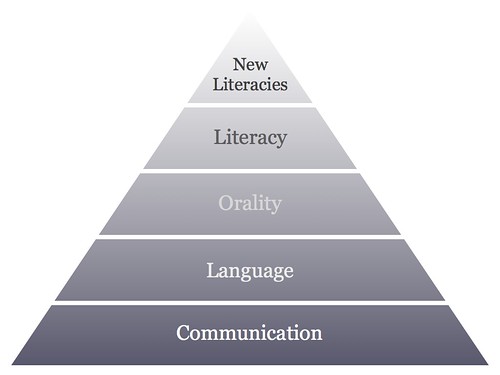Literacy -> Digital Flow: Tetrads & Connectivism.
This follows on from a previous post Literacy -> Digital Flow: digital epistemologies & ontology. References can be found on my wiki.
What we are asking here is, effectively, what changes when a new technology is introduced? How does affect how we interact, how we think and how we communicate? Useful here may be Marshall McLuhan’s idea of ‘tetrads’ (as set out in his posthumously-published Laws of Media).
(image from Wikimedia Commons)
Any medium or human artefact simultaneously enhances, reverses, retrieves and obsolesces – although the effects in each area may take years to manifest themselves. If we take the mobile phone (cellphone) as an example to place in the centre of the tetrad, we observe the following. The mobile phone enhances communication by voice whilst reversing the need to keep people close in order to communicate with them. Public telephone booths become obsolete, but certain behaviours (such as infantile shouting) are retrieved.
McLuhan also believed that technologies have to be understood in their historical context, using the idea of ‘figure and ground’ to underpin his famous phrase ‘the medium is the message’. The figure (or medium) operates through its ground (or context) with both having to be understood together to make either intelligible. McLuhan believed that each technology reflects a way of understanding the world, especially in terms of time and space. Attempting to understand a particular technology or medium without the culture in which it was used would be at best anachronistic and at worst useless and misleading.
This idea of each medium having its own tetradic influence, along with McLuhan’s borrowing of the concept of ‘figure and ground’ from Gestalt psychology would seem to make the idea of a single, monolithic ‘digital literacy’ untenable. Not only does the ‘digital’ refer to devices that cover many cultural niches and time periods, but each obeys McLuhan’s Laws of Media in different ways. We have moved from a psychological view of understanding literacy (as with Traditional Literacy) to a sociological view where ‘[l]iteracies are bound up with social, institutional and cultural relationships, and can only be understood when they are situated within their social, cultural and historical contexts’ (Lankshear & Knobel, 2006:12).
As Lankshear and Knobel go on to mention, literacy is always connected to social identity, to being a particular type of person. This is necessarily singular in a world where communication is bounded by physicality, but in a digital world may be multiple. Online I may have as many personas and identities as I have accounts. This has led to what is known as ‘affinity spaces’ – places where informal learning takes place amongst people who have a shared activity, interest or goal (Gee, 2004). This could be a war-game played online through an identity symbolised through a ‘butch’ soldier avatar, involvement of a photo-sharing community where members post comments, ideas and tips on each others’ work, or a fan fiction arena where members share a love of a particular film/TV series/book. It is not difficult to imagine an individual involving themselves in each of these communities simultaneously using a different identity, avatar, and persona each time. These multiple identities are predicated upon ‘the recognition of “difference” and hyperplurality… suggest[ing] that the emerging architecture of world order is moving away from territorially distinct, mutually exclusive, linear orderings of space toward nonlinear, multiperspectival, overlapping layers of political authority. Likewise, modern mass identities centred on the “nation” are being dispersed into multiple, nonterritorial “niche” communities and fragmented identities’ (Deibert, 1996:201 quoted in Hawisher & Selfe, 2000:288)
If communities are defined by communication and creative acts, and if these two activities are based upon some form of literacy, then literacies must be multiple, ever-changing and quickly evolving. In fact, it is difficult to see how such a generalised notion of ‘digital literacy’ would have time to ‘solidify’ and reside within an individual in a pure form. Instead, using theories such as Connectivism to conceive of learning – and therefore literacies – as residing in networks may be more sustainable. Considering education in terms of Discourse(s) rather than as transmission leads to,
thinking of education and learning in terms not of schools and children (place-related and age-specific) but, instead, in terms of human lives as trajectories through diverse social practices and institutions… To learn something is to progress toward a fuller understanding and fluency with doing and being in ways that are recognized as proficient relative to recognized ways of ‘being in the world’ (Lankshear & Knobel, 2006:196)
Social practices become both all-important and compartmentalized. Learners as ‘nodes on a network’ can gain identity and status whilst simultaneously helping shape what, for that particular community, is an accepted and recognized way of ‘being in the world’. As Siemens, one of the developers of the theory of Connectivism puts it,
The starting point of connectivism is the individual. Personal knowledge is comprised of a network, which feeds into organizations and institutions, which in turn feed back into the network, and then continue to provide learning to individuals. This cycle of knowledge development (personal to network to organization) allows learners to remain current in their field through the connections they have formed. (Siemens, 2004:no page)
In a world where the ‘half-life’ of knowledge – ‘the time span from when knowledge is gained to when it becomes obsolete’ (Gonzalez, 2004 quoted by Siemens, ibid.) – is shrinking rapidly, such networked learning and associated literacies are essential.


